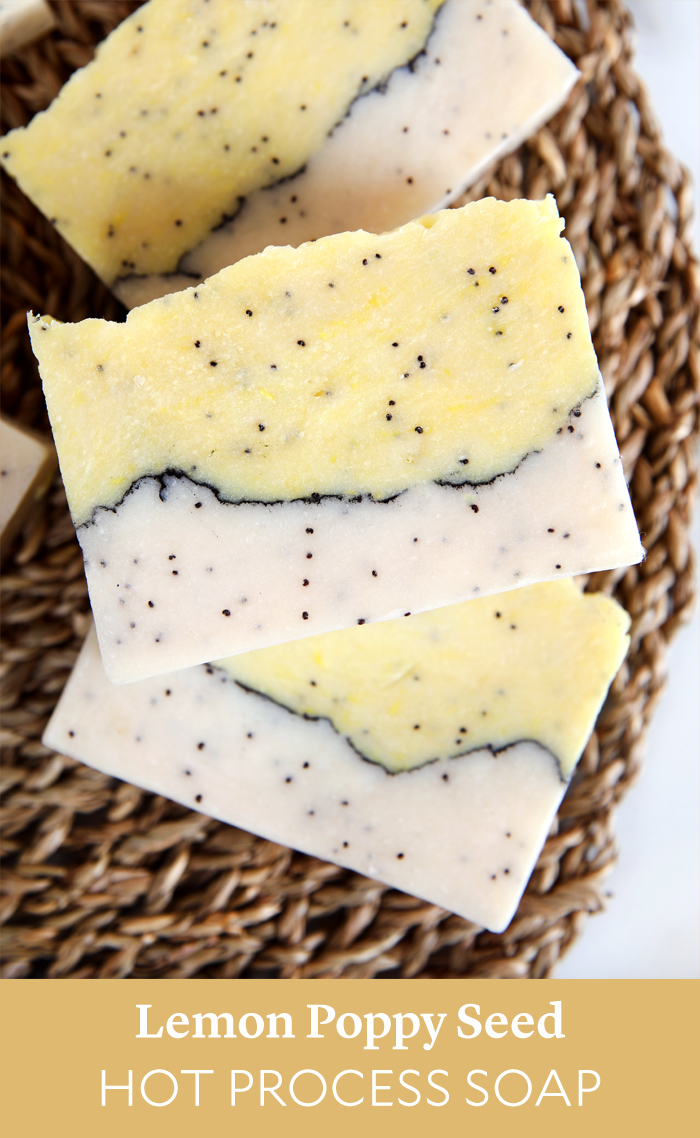
Lemon and poppy seeds are a classic combination. This hot process recipe is scented with a bright and bubbly combination of Lemon Verbena and Champagne Fragrance Oil. It’s also made with poppy seeds for exfoliation. The end result is a cheerful bar that smells great and leaves skin feeling smooth.
Love the look of these bars, but prefer cold process soap? This project is based off our popular Lemon Poppy Seed Cold Process Soap. Cold process soap is smoother than hot process, which means you can create a straight mica line. Click here to watch this recipe in action.
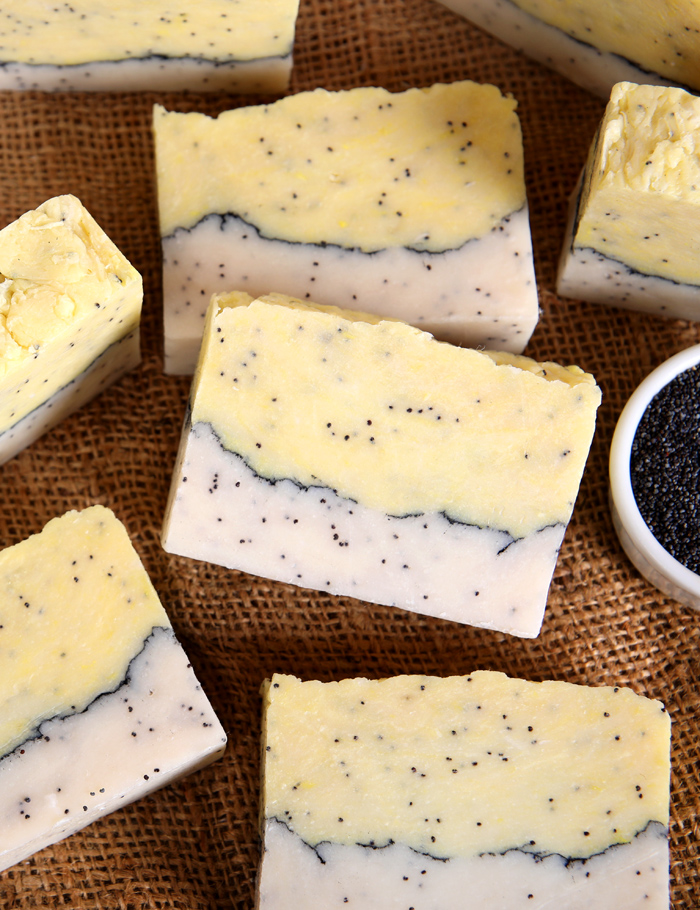
One of the great things about this process is the extra heat speeds up saponification. That means the soap is ready to use after 24 hours and it doesn’t need a 4-6 week cure time like cold process soap. We still like to let our hot process soap cure for 1-2 weeks, just to make sure any excess water has evaporated.
Lemon Poppy Seed Hot Process Soap
What You Need:
10″ Silicone Loaf Mold
33 oz. Lots of Lather Quick Mix
4.7 oz. Sodium Hydroxide
10.9 oz. Distilled Water
1 oz. Sodium Lactate
0.5 oz. Lemon Verbena Yankee Type Fragrance Oil
1 oz. Champagne Fragrance Oil
Poppy Seeds
Yellow Mica
Activated Charcoal
If you’ve never made hot process soap before, stop here. Check out our FREE four-part SoapQueen.tv series on cold process soapmaking, especially the episode on lye safety. Bramble Berry also carries a wide range of books on the topic, including Pure Soapmaking.
FRAGRANCE PREP: Measure 0.5 ounces of Lemon Verbena Yankee Type Fragrance Oil and 1 ounce of Champagne Fragrance Oil into a small glass container and set aside.
COLOR PREP: Disperse 1 teaspoon of Yellow Mica into 1 tablespoon of lightweight liquid oil. Sunflower, sweet almond, or canola are great options. Stir or use a mini mixer to help get rid of clumps. Set aside. Have activated charcoal nearby, along with a powder duster or fine mesh sifter.
SAFETY FIRST: Suit up for safe handling practices. That means goggles, gloves, and long sleeves. Make sure kids, pets, other distractions, and tripping hazards are out of the house or don’t have access to your soaping space. Always soap in a well-ventilated area.
ONE: Slowly and carefully add the 4.7 ounces lye to 10.9 ounces distilled water and gently stir until the lye has fully dissolved and the liquid is clear. Set aside to cool. Once cooled to about 130° F, add the 1 ounce sodium lactate to the lye water. Sodium lactate is used in hot process at 3% of the oil weight to help produce a smoother bar.
TWO: Fully melt the entire bag of Lots of Lather Quick Mix until it’s completely clear and there’s no cloudiness. Shake the bag to mix up all the oils. Measure 33 oz. into your Crock-Pot and turn it on.
NOTE: The heat setting you use may vary depending on your cooking vessel. We have cooked hot process soap on low and high heat with equally good results. For this recipe, we used the high heat setting for a faster cook time. If you’re making hot process soap in your cooking vessel for the first time, start with the low setting. Next time try the high setting and see which you prefer.
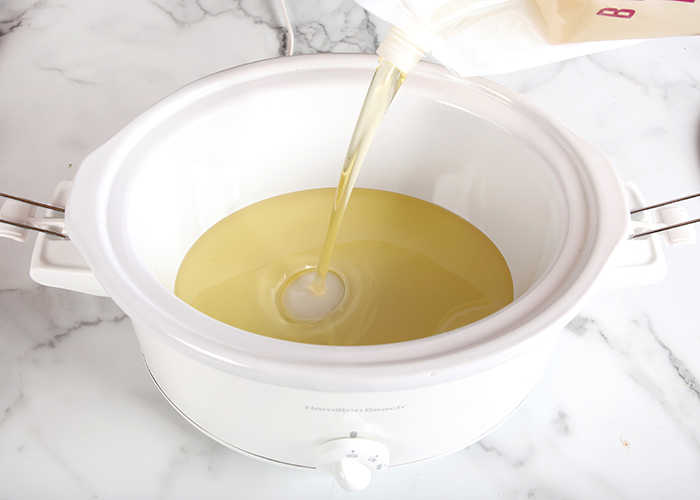 THREE: Slowly add the lye water to the oils. Make sure the mixture does not fill up more than half of the pot. Tap the stick blender on the bottom of the pot to release air bubbles and begin to blend.
THREE: Slowly add the lye water to the oils. Make sure the mixture does not fill up more than half of the pot. Tap the stick blender on the bottom of the pot to release air bubbles and begin to blend.
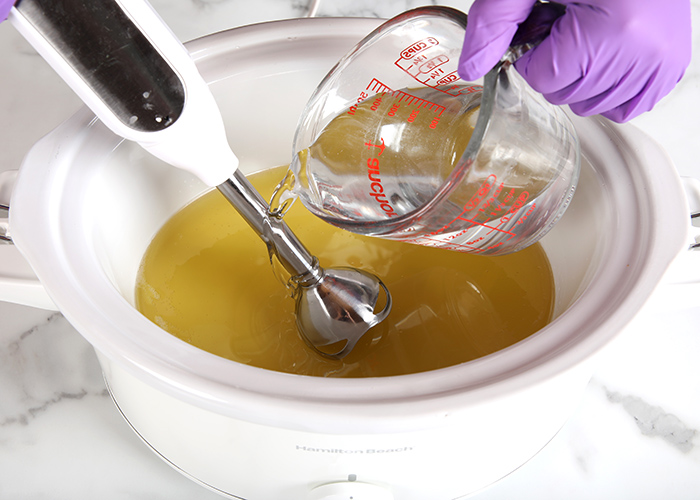 FOUR: Mix with a stick blender until thick trace. Put the lid on the Crock-Pot and allow the soap to start cooking.
FOUR: Mix with a stick blender until thick trace. Put the lid on the Crock-Pot and allow the soap to start cooking.
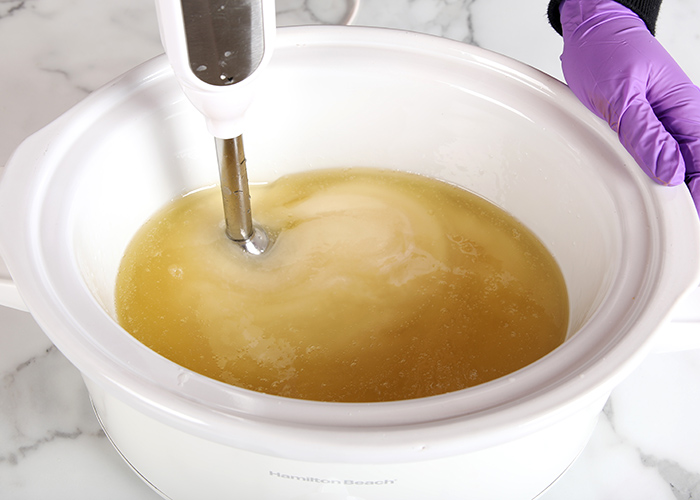
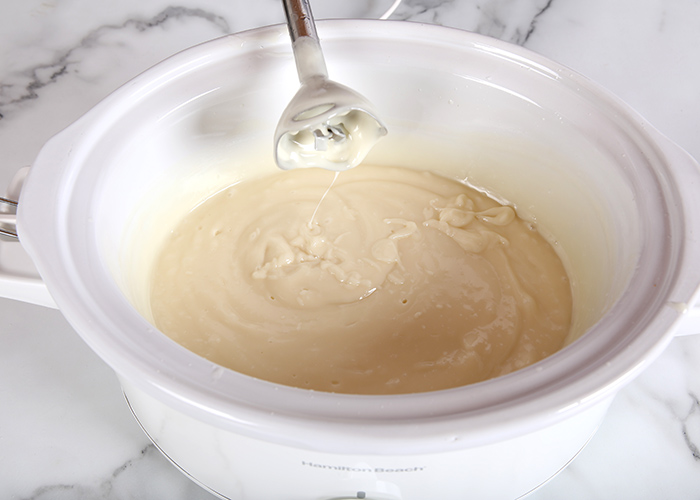 FIVE: After about 10-15 minutes, check the soap. Starting from the outside, the texture and color of the soap will start to change into a glossy, slightly Vaseline-like texture.
FIVE: After about 10-15 minutes, check the soap. Starting from the outside, the texture and color of the soap will start to change into a glossy, slightly Vaseline-like texture.
NOTE: Don’t be surprised if the soap starts to grow in volume. Do not leave your soap unattended in the first 10 minutes of cook time for this reason. If the soap gets too high in the pot, make sure you’re wearing gloves, take the pot off heat, and stir like crazy.
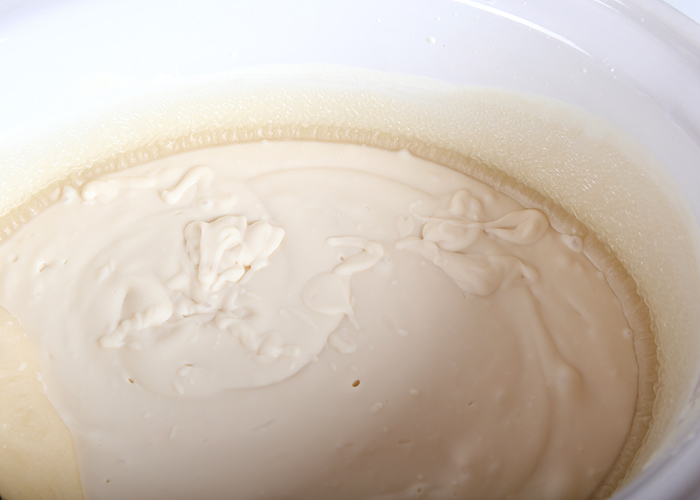 SIX: Stir the batch to ensure even cooking. Place the lid back on the pot and allow it to cook for about another 10-20 minutes. The time may vary depending on the temperature of your Crock-Pot. Keep an eye on it, checking it every 5-10 minutes or so.
SIX: Stir the batch to ensure even cooking. Place the lid back on the pot and allow it to cook for about another 10-20 minutes. The time may vary depending on the temperature of your Crock-Pot. Keep an eye on it, checking it every 5-10 minutes or so.
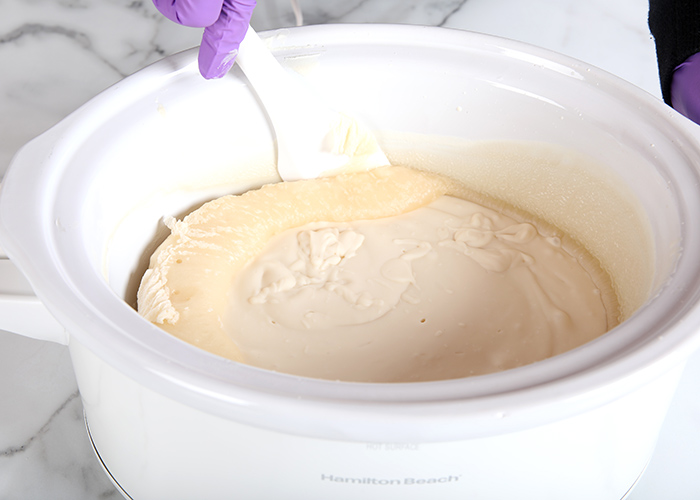
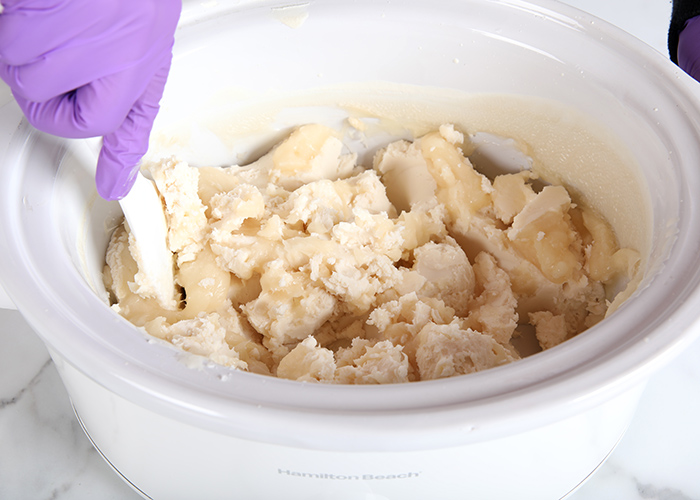 SEVEN: The batch is ready when it’s the texture of glossy mashed potatoes. To be sure, use a pH strip. Place a small amount of the soap into a cup of distilled water and stir. Dip the pH strip into the water – it should be below 10. Be sure not to overcook the soap, you don’t want it too dry for the next steps.
SEVEN: The batch is ready when it’s the texture of glossy mashed potatoes. To be sure, use a pH strip. Place a small amount of the soap into a cup of distilled water and stir. Dip the pH strip into the water – it should be below 10. Be sure not to overcook the soap, you don’t want it too dry for the next steps.
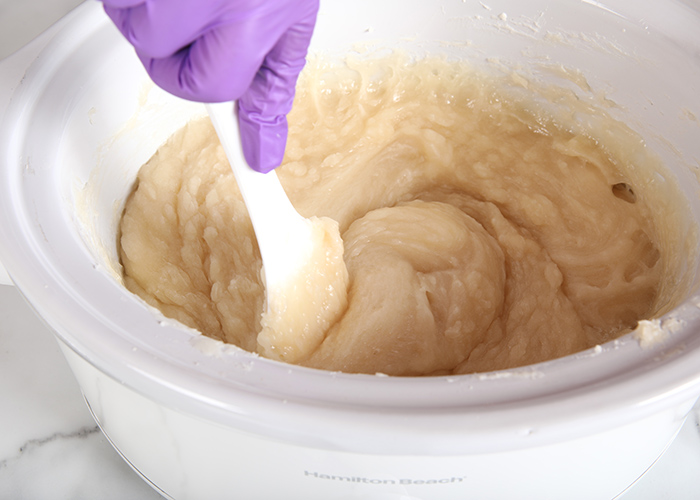 EIGHT: Add 2 teaspoons of poppy seeds directly to the soap and stir.
EIGHT: Add 2 teaspoons of poppy seeds directly to the soap and stir.
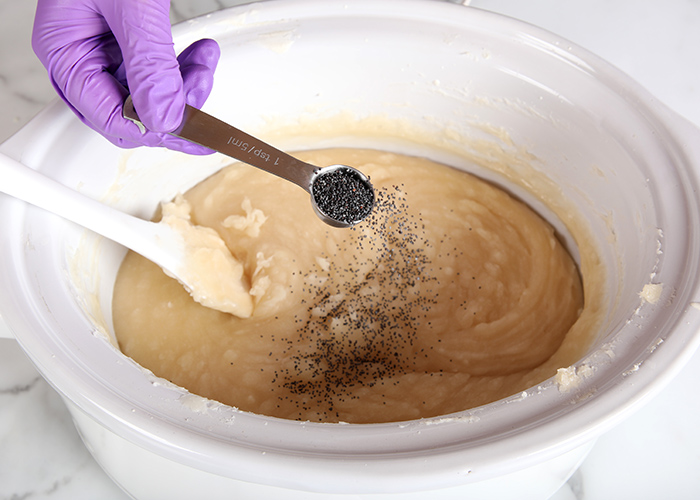 NINE: Add all of the fragrance blend and use a large spatula to stir in thoroughly.
NINE: Add all of the fragrance blend and use a large spatula to stir in thoroughly.
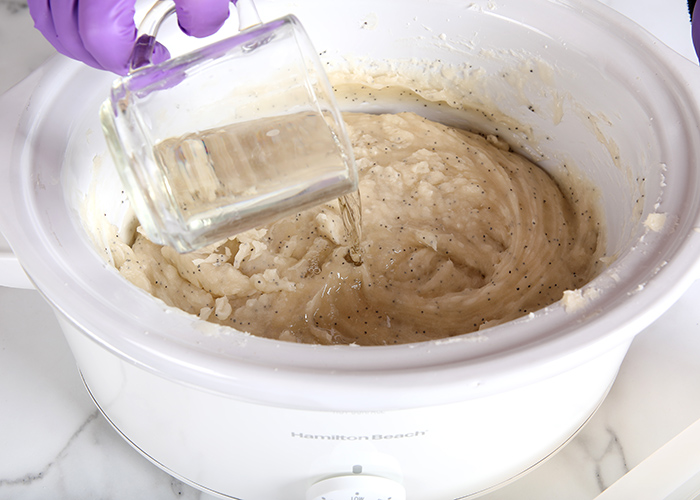 TEN: Use a large spatula to transfer half of the soap to the mold. Tap firmly on the counter to even the soap out and get rid of bubbles. Place about 1 teaspoon of activated charcoal into the powder duster and quickly apply a thin layer onto the soap. Be careful to not add too much, or the top layer may not stick.
TEN: Use a large spatula to transfer half of the soap to the mold. Tap firmly on the counter to even the soap out and get rid of bubbles. Place about 1 teaspoon of activated charcoal into the powder duster and quickly apply a thin layer onto the soap. Be careful to not add too much, or the top layer may not stick.
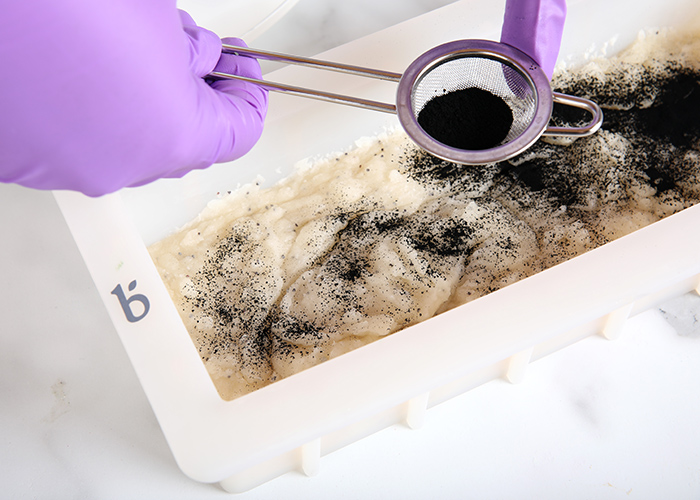
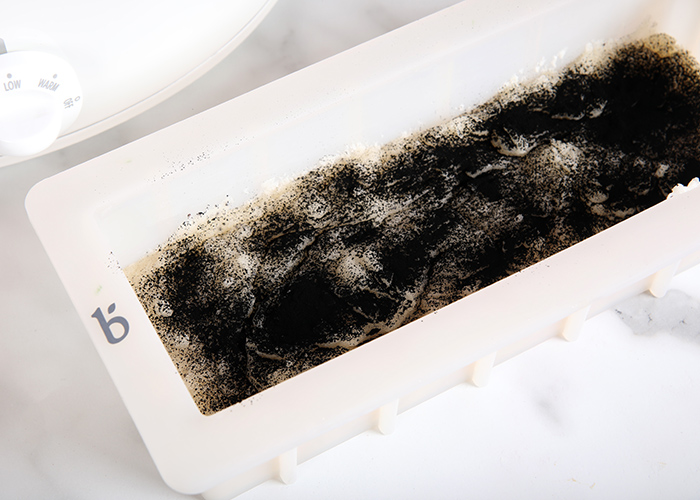 ELEVEN: Add all of the dispersed Yellow Mica to the remaining soap and stir. Plop the soap into the mold and use your gloved hands to press it in. Tap firmly on the counter to help the soap evenly distribute.
ELEVEN: Add all of the dispersed Yellow Mica to the remaining soap and stir. Plop the soap into the mold and use your gloved hands to press it in. Tap firmly on the counter to help the soap evenly distribute.
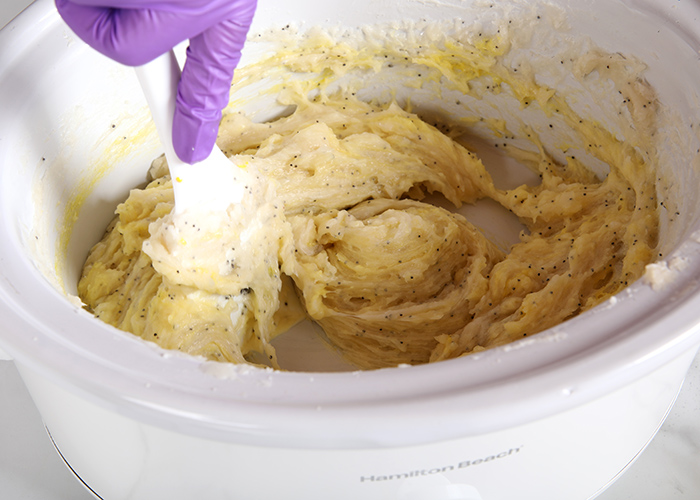
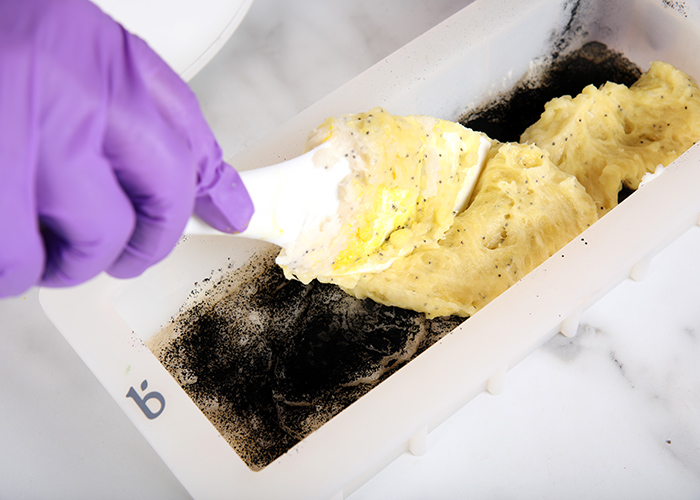
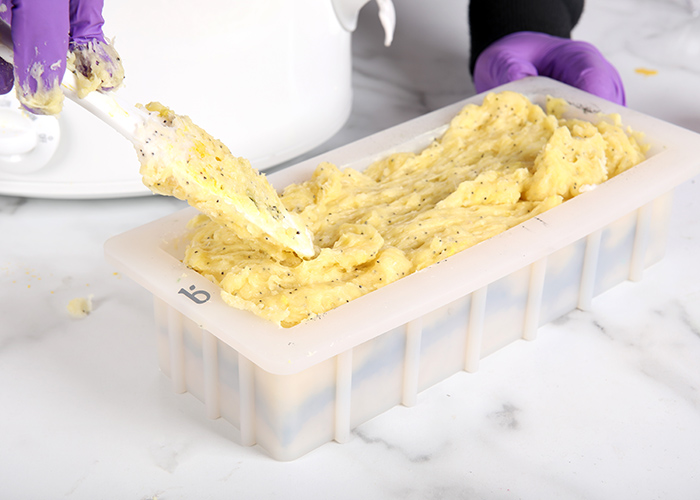 TWELVE: Allow the soap to stay in the mold for at least 24 hours. Unmold and cut into bars. This soap is ready to use right away, but will last longer in the shower after at least a 2 week cure time. Enjoy!
TWELVE: Allow the soap to stay in the mold for at least 24 hours. Unmold and cut into bars. This soap is ready to use right away, but will last longer in the shower after at least a 2 week cure time. Enjoy!
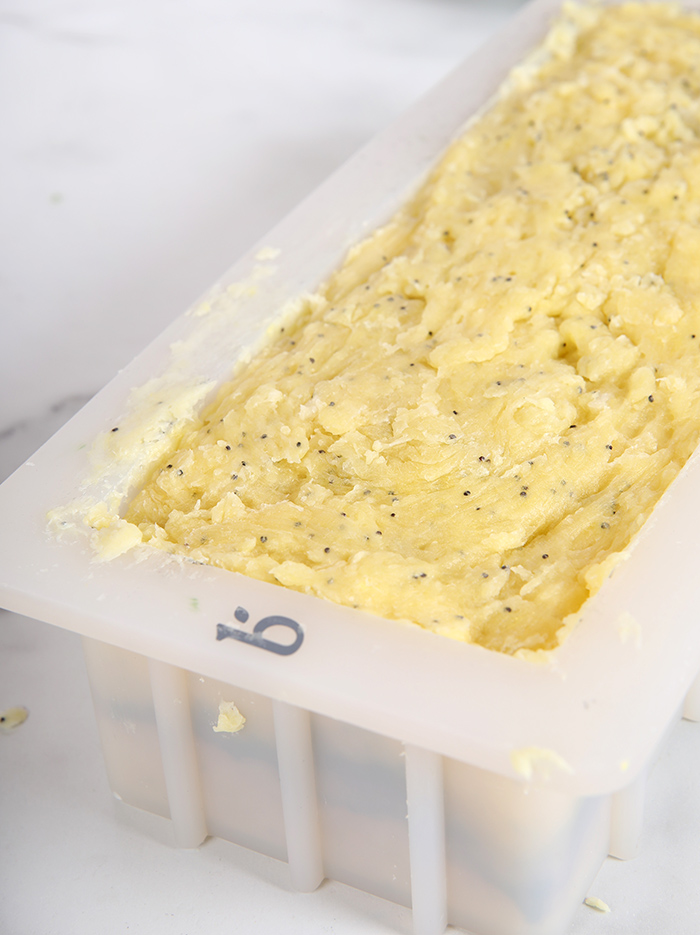
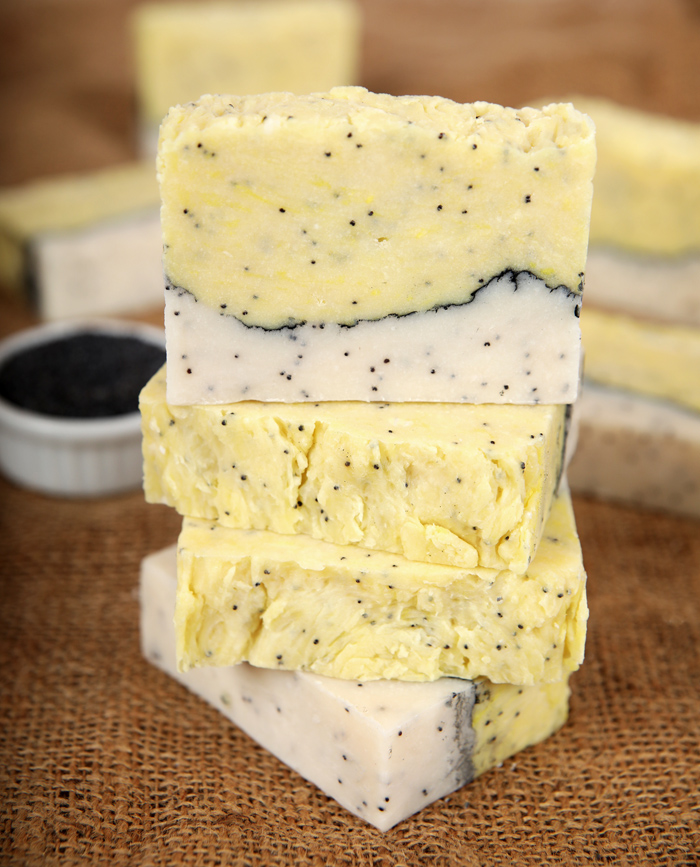
- 10″ Silicone Loaf Mold
- 33 oz. Lots of Lather Quick Mix
- 4.7 oz. Sodium Hydroxide
- 10.9 oz. Distilled Water
- 1 oz. Sodium Lactate
- 0.5 oz. Lemon Verbena Yankee Type Fragrance Oil
- 1 oz. Champagne Fragrance Oil
- Poppy Seeds
- Yellow Mica
- Activated Charcoal
- Slowly and carefully add the 4.7 ounces lye to 10.9 ounces distilled water and gently stir until the lye has fully dissolved and the liquid is clear. Set aside to cool. Once cooled to about 130° F, add the 1 ounce sodium lactate to the lye water. Sodium lactate is used in hot process at 3% of the oil weight to help produce a smoother bar.
- Fully melt the entire bag of Lots of Lather Quick Mix until it’s completely clear and there’s no cloudiness. Shake the bag to mix up all the oils. Measure 33 oz. into your Crock-Pot and turn it on. NOTE: The heat setting you use may vary depending on your cooking vessel. We have cooked hot process soap on low and high heat with equally good results. For this recipe, we used the high heat setting for a faster cook time. If you’re making hot process soap in your cooking vessel for the first time, start with the low setting. Next time try the high setting and see which you prefer.
- Slowly add the lye water to the oils. Make sure the mixture does not fill up more than half of the pot. Tap the stick blender on the bottom of the pot to release air bubbles and begin to blend.
- Mix with a stick blender until thick trace. Put the lid on the Crock-Pot and allow the soap to start cooking.
- After about 10-15 minutes, check the soap. Starting from the outside, the texture and color of the soap will start to change into a glossy, slightly Vaseline-like texture. NOTE: Don’t be surprised if the soap starts to grow in volume. Do not leave your soap unattended in the first 10 minutes of cook time for this reason. If the soap gets too high in the pot, make sure you’re wearing gloves, take the pot off heat, and stir like crazy.
- Stir the batch to ensure even cooking. Place the lid back on the pot and allow it to cook for about another 10-20 minutes. The time may vary depending on the temperature of your Crock-Pot. Keep an eye on it, checking it every 5-10 minutes or so.
- The batch is ready when it’s the texture of glossy mashed potatoes. To be sure, use a pH strip. Place a small amount of the soap into a cup of distilled water and stir. Dip the pH strip into the water – it should be below 10. Be sure not to overcook the soap, you don’t want it too dry for the next steps.
- Add 2 teaspoons of poppy seeds directly to the soap and stir.
- Add all of the fragrance blend and use a large spatula to stir in thoroughly.
- Use a large spatula to transfer half of the soap to the mold. Tap firmly on the counter to even the soap out and get rid of bubbles. Place about 1 teaspoon of activated charcoal into the powder duster and quickly apply a thin layer onto the soap. Be careful to not add too much, or the top layer may not stick.
- Add all of the dispersed Yellow Mica to the remaining soap and stir. Plop the soap into the mold and use your gloved hands to press it in. Tap firmly on the counter to help the soap evenly distribute.
- Allow the soap to stay in the mold for at least 24 hours. Unmold and cut into bars. This soap is ready to use right away, but will last longer in the shower after at least a 2 week cure time. Enjoy!
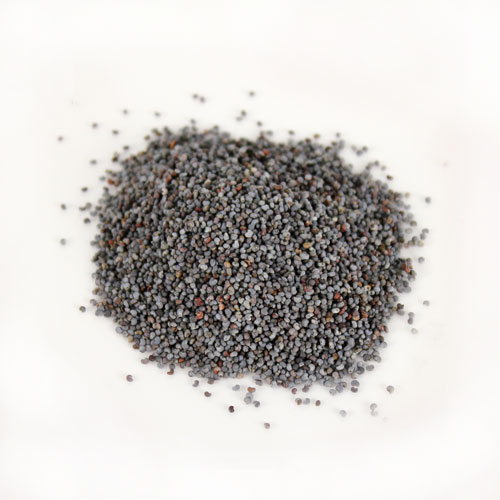
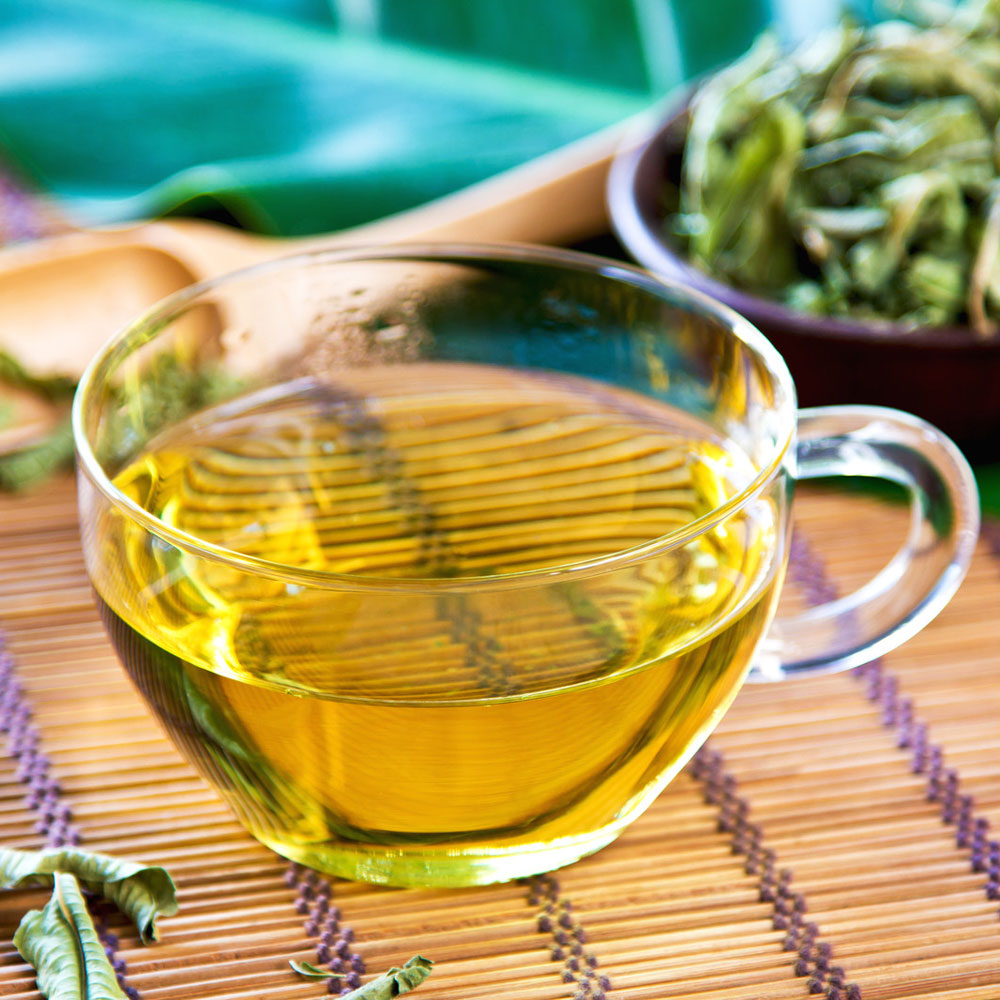

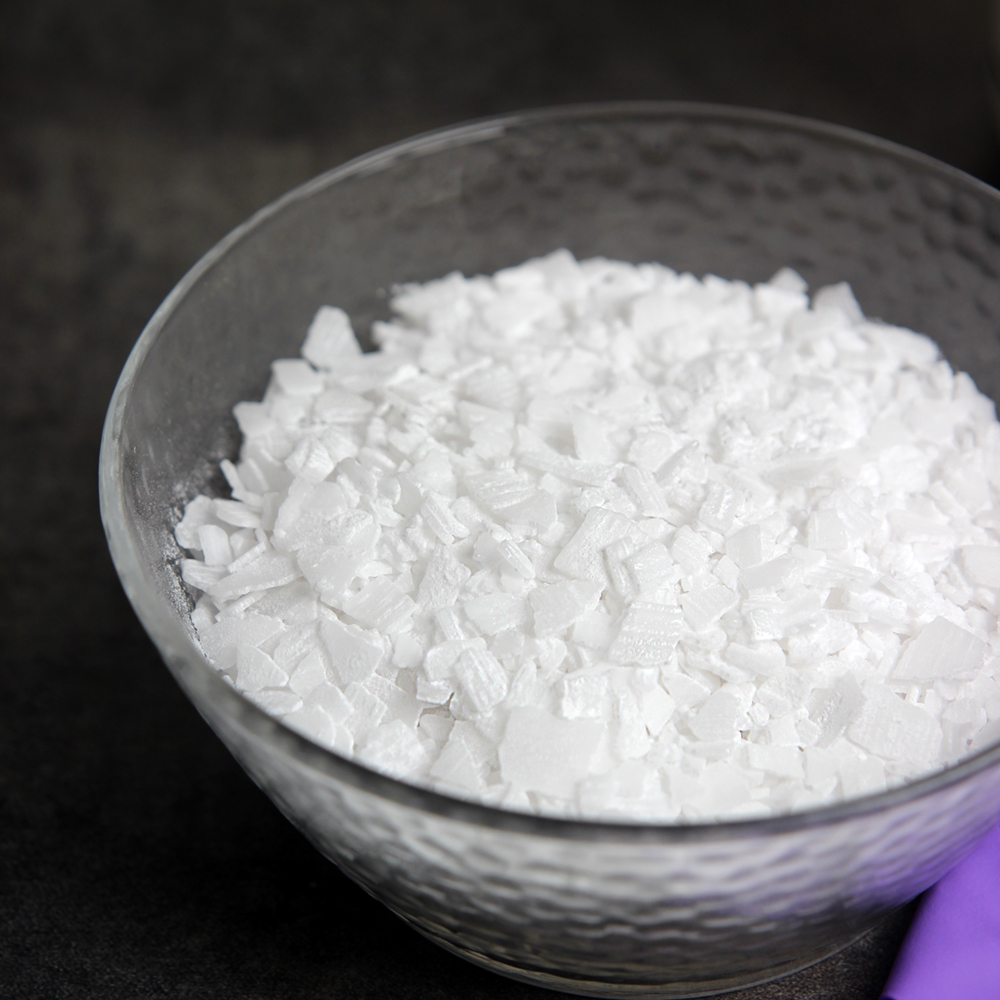
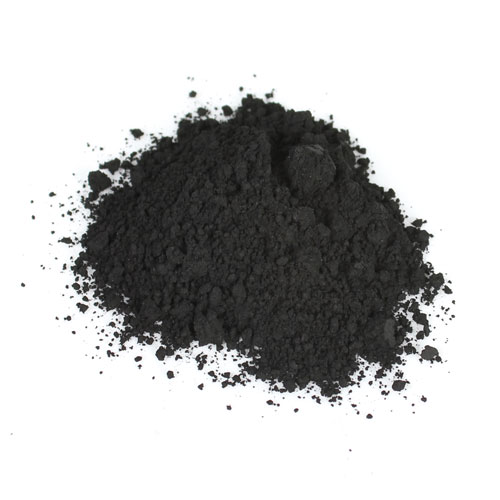
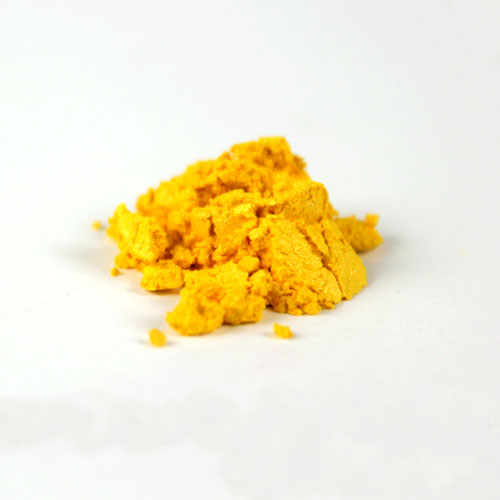
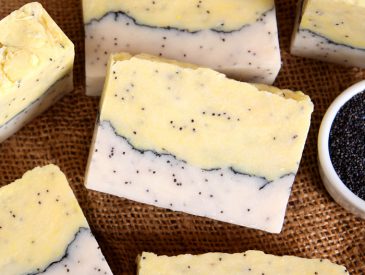


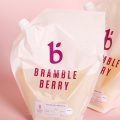

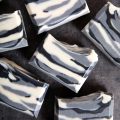
Your ” soap queen ” website has an add to cart option at the end of the list for supplies needed. It appears you ” offer a lot of all supplies ” to make each soap. The add to cart option isn’t working. What’s going on ?
In the Studio is where we will be storing new projects like that.
https://www.brambleberry.com/in-the-studio
The blog has moved so it will not longer link back to the website for purchases. We are keeping it up so you can refer to old recipes and articles. Find out more about that here: https://www.soapqueen.com/bramble-berry-news/the-blog-has-moved/
You can find all of our products to purchase at http://www.brambleberry.com
This was my first hot process recipe and it turned out well — so excited! One question – the activated charcoal got along the sides of the mold before I put the second layer in. When the soap unmolded, there was a substantial amount of charcoal on the sides of each bar. Do you have any tips on how to wipe the charcoal out before pouring the second layer?
You could try taking a dry brush to dust down the charcoal that got up on the sides. If some of the charcoal does make it on the sides of your other layers you can try gently wiping it away with a little bit of 99% Isopropyl Alcohol and a paper towel.
Thank you!!
I would like to use pure grade essential oils, would that work and how much would I use?
Yes, our essential oils are 100% pure and undiluted. How much you use depends on which EO you choose to use. Find out how much of our EOs to use with our Fragrance Calculator.
Essential Oils: https://www.brambleberry.com/Essential-Oils-C157.aspx
Fragrance Calculator: https://www.brambleberry.com/Pages/Fragrance-Calculator.aspx
In the fragrance calculator for lemon Verbena it says it’s the same amount for melt and pour and cold process soap. Can that be right ?
Yes, with some fragrances the usage rate will be the same in both MP and CP soaps.
I learned the hard way that you shouldn’t apply too much charcoal. I had a beautiful white base with a charcoal line and a purple, plum, and white Clyde Slide that worked perfectly. I applied way too much charcoal, and the layers separated. Such a shame. The soap still works great though!
Do you put in cold process or melt and pour in the fragrance calculator for hot process soap ? I wish you had hot process as an option.
It is the same as Cold Process, you are just accelerating the saponification process as it says in the beginning of the post,, by adding the heat!
Rita, you are supposed to pick Rebatch option in Fragrance calculator for Hot Process soap as that’s basically the same. Not Cold Process or Melt and Pout. HTH 🙂